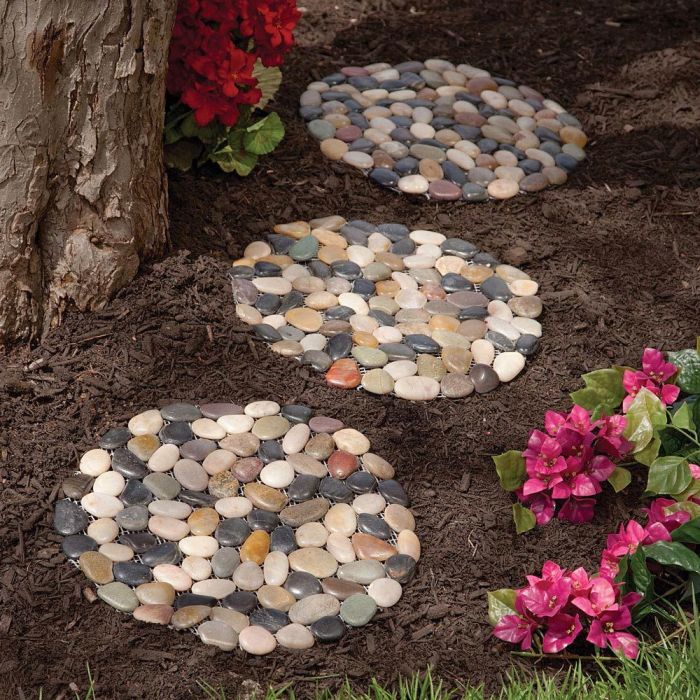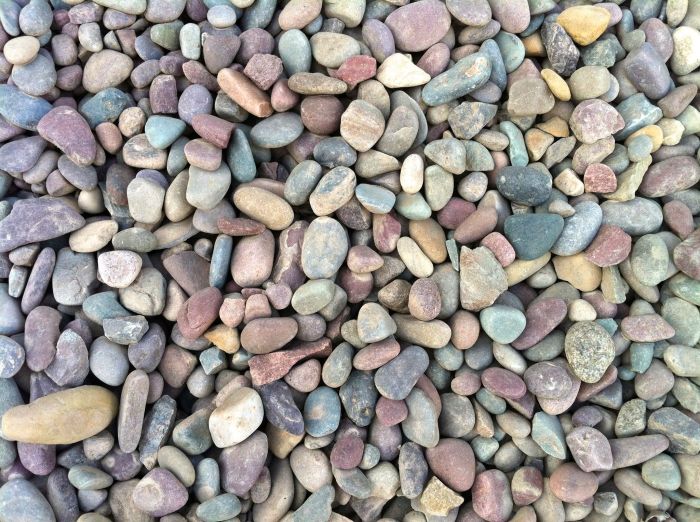Decorative garden stones: transforming ordinary gardens into extraordinary havens. From sleek modern designs to rustic charm, these versatile elements add texture, color, and personality to any outdoor space. Whether you’re creating winding pathways, eye-catching borders, or stunning focal points, the possibilities are as limitless as your imagination. This guide explores the diverse world of decorative garden stones, offering insights into their types, placement, and maintenance, empowering you to create a garden that truly reflects your unique style.
We’ll delve into the various materials, shapes, and artistic styles available, providing practical advice on incorporating these elements into different garden designs. Learn how to choose the perfect stones for your landscape, create visually appealing pathways and borders, and maintain their beauty for years to come. Prepare to unlock the potential of decorative garden stones and elevate your garden to new heights of aesthetic appeal.
Types and Styles of Decorative Garden Stones

Decorative garden stones offer a versatile and aesthetically pleasing way to enhance outdoor spaces. Their diverse materials, shapes, sizes, and artistic styles provide homeowners with a wide range of options to personalize their gardens, pathways, and landscaping. Choosing the right stones depends on factors such as budget, desired aesthetic, and the overall design of the garden.
Material Comparison of Decorative Garden Stones
The choice of material significantly impacts the durability, cost, appearance, and maintenance of your garden stones. Below is a comparison of popular materials:
| Material | Durability | Cost | Aesthetic Appeal | Maintenance |
|---|---|---|---|---|
| Granite | Very High; resistant to weathering and cracking | High | Classic, elegant; comes in a variety of colors and patterns | Minimal; occasional cleaning |
| Slate | High; durable but can be prone to chipping | Medium-High | Natural, rustic; often features layered textures and subtle color variations | Minimal; occasional cleaning |
| Marble | Medium; susceptible to etching and staining | High | Elegant, luxurious; often features veining and a polished finish | Moderate; requires sealing and regular cleaning |
| Concrete | Medium; can crack under extreme conditions | Low | Versatile; can be molded into various shapes and colors; can mimic natural stone | Low; occasional cleaning |
Shapes and Sizes of Decorative Garden Stones
The shape and size of garden stones contribute significantly to their overall impact on the garden design. Consider the following options:
A wide variety of shapes and sizes are available, each offering unique design possibilities. Careful consideration of these factors ensures harmonious integration within your garden’s overall aesthetic.
- Stepping Stones: Typically square, rectangular, or circular, ranging from 12 to 24 inches in diameter, providing functional pathways.
- Pebbles: Small, irregularly shaped stones, used for ground cover, borders, or decorative accents; sizes vary greatly.
- Spheres: Smooth, round stones, available in various sizes, adding a modern or whimsical touch.
- Mosaics: Small stones arranged in intricate patterns to create artistic designs; size varies depending on the design.
Artistic Styles and Designs of Decorative Garden Stones
Garden stones reflect a wide range of artistic styles, from the natural to the highly stylized. Selecting a style that complements the existing garden design is crucial.
The diverse artistic styles available allow for the creation of personalized and unique garden features. The choice depends on the overall aesthetic of the garden and personal preference.
- Natural: Stones with minimal processing, showcasing their natural texture and color; often irregular shapes and sizes.
- Rustic: Stones with a weathered or aged appearance, often featuring rough textures and muted colors; evokes a sense of age and history.
- Modern: Stones with clean lines, geometric shapes, and smooth surfaces; often featuring bold colors or metallic accents.
- Whimsical: Stones with unique shapes, playful designs, or hand-painted details; adds a touch of personality and fun.
Placement and Design Ideas for Decorative Garden Stones

Decorative garden stones offer a versatile and visually appealing way to enhance any outdoor space. Their effectiveness hinges on thoughtful placement and integration with the overall garden design. Consider the style of your garden, the size and shape of the stones, and the desired aesthetic impact when planning your stone arrangement. This section explores practical strategies and creative ideas for maximizing the visual appeal of your garden stones.
Step-by-Step Guide to Incorporating Decorative Garden Stones into Different Garden Styles
Effectively integrating decorative garden stones requires a tailored approach based on the existing garden style. Following a systematic process ensures a cohesive and visually pleasing result.
- Assess Your Garden Style: Determine whether your garden is formal, informal, cottage, Japanese, or another style. Formal gardens benefit from structured arrangements, while informal gardens embrace a more natural, free-flowing look. Cottage gardens often incorporate rustic stones, whereas Japanese gardens might use more minimalist, natural-looking stones.
- Select Appropriate Stones: Choose stones that complement your garden’s style. Formal gardens might use uniform, precisely cut stones, while informal gardens might use a mix of sizes and shapes with natural variations in color and texture. Cottage gardens might use weathered, rustic stones, and Japanese gardens might opt for smooth, grey stones like river rocks.
- Plan Placement Strategically: Consider the placement of stones in relation to existing plants, pathways, and other garden features. In a formal garden, stones might be arranged in straight lines or geometric patterns. In an informal garden, a more meandering, less structured arrangement is appropriate. Cottage gardens might use stones to define borders or create small, intimate seating areas. Japanese gardens often use stones to create focal points or to suggest a natural landscape.
- Prepare the Area: Before placing the stones, prepare the ground by removing weeds, leveling the surface, and adding a layer of gravel or sand for stability, particularly for larger stones.
- Install the Stones: Carefully place the stones, adjusting their position until you achieve the desired look. For larger stones, use a level to ensure they are properly seated. For smaller stones, you can create patterns or designs by arranging them in specific configurations.
- Maintain and Enhance: Regularly inspect the stones and remove any weeds or debris that may accumulate around them. Over time, you may wish to add or rearrange stones to enhance the overall aesthetic appeal of your garden.
Design Ideas for Pathways and Borders Using Decorative Garden Stones
Pathways and borders provide excellent opportunities to showcase the beauty and versatility of decorative garden stones. The choice of stone type and arrangement significantly impacts the overall aesthetic.
For a formal garden pathway, consider using uniform, rectangular paving stones in a consistent pattern. Imagine a pathway made of smooth, grey flagstones, laid in a straight line with precise spacing. This creates a clean, sophisticated look. For a more informal pathway, use a mix of sizes and shapes of natural stones, such as river rocks or flagstones in varying shades of brown and beige, arranged in a meandering pattern to create a rustic and natural feel.
The irregular shapes and colors add visual interest and complement the informal style of the garden. A cottage garden border might use a mix of small, tumbled stones in muted colors, creating a rustic and charming edge. A Japanese garden pathway could utilize stepping stones made of flat, grey stones, spaced strategically to create a sense of movement and contemplation.
Using Decorative Garden Stones to Create Focal Points and Highlight Garden Features
Strategic placement of decorative garden stones can effectively draw attention to specific areas or features within a garden. Consider the size, color, and texture of the stones in relation to the surrounding elements.
For example, a grouping of large, intricately carved stones can create a dramatic focal point in a formal garden. These stones could be arranged in a circular pattern around a small fountain or statue. In a more naturalistic setting, a collection of smaller, irregularly shaped stones in varying shades of brown and grey could be used to highlight a particularly vibrant flowerbed or a unique plant.
The contrast in color and texture would draw the eye to the featured area. In a Japanese garden, a single, carefully placed boulder can serve as a powerful focal point, symbolizing strength and permanence. The simplicity and natural beauty of the stone enhance the overall meditative atmosphere of the garden.
With the right selection and placement, decorative garden stones can effortlessly elevate your garden’s aesthetic appeal. From carefully curated pathways to striking focal points, these versatile elements offer a blend of functionality and beauty. By understanding the various types, design ideas, and maintenance techniques, you can transform your outdoor space into a personalized oasis. Embrace the artistry of garden stones and create a landscape that reflects your unique vision and style, ensuring a captivating and enduring outdoor haven.